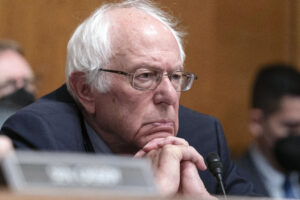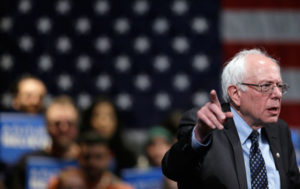The Truth About Medicare-for-All Its Opponents Won’t Admit
Contrary to what Michael Bloomberg and Howard Schultz might have you believe, the plan could save taxpayers upward of $1.5 trillion. Sen. Bernie Sanders, I-Vt. (Gage Skidmore / Flickr)
Sen. Bernie Sanders, I-Vt. (Gage Skidmore / Flickr)
What follows is a conversation among the Policy of Economic Research Institute’s Robert Pollin, President of Physicians for a National Health Program Adam Gaffney and Sharmini Peries of the Real News Network. Read a transcript of their conversation below or watch the video at the bottom of the post.
SHARMINI PERIES: It’s The Real News Network. I’m Sharmini Peries, coming to you from Baltimore.
As the 2020 presidential race gets underway, one of the main issues being discussed is Medicare for All. Now, Senator Kamala Harris and Senator Cory Booker and Elizabeth Warren have all announced their candidacies. And Senator Sanders is expected to do so very soon. They have all, of course, presented versions of Medicare for All. Weighing in recently on all of their proposals were two billionaires who also are considering a run in 2020, and that is the former New York City Mayor Michael Bloomberg and the CEO of Starbucks Howard Schultz. Now let’s listen to Bloomberg making an argument against Medicare for All, where he says it won’t work.
MICHAEL BLOOMBERG: I think you can have Medicare for All for people that are covered, because that’s a smaller group, and a lot of them are taking care of Medicaid already, Medicare. But to replace the entire private system where companies provide health care for their employees would bankrupt us for a very long time. It’s just not a practical thing.
SHARMINI PERIES: Then there was Howard Schultz, the CEO of Starbucks, making a slightly different argument on the View.
SPEAKER: Well, I just want to ask quickly, what are the Dems too left on, you think? What issues will [inaudible].
HOWARD SCHULTZ: I don’t know Senator Harris, but listening to her last night say we should abolish the insurance industry as a way to go forward on health care, that alone would wipe out millions of jobs of Americans. And that is the kind of extreme policy that is not a policy that I agree with.
SHARMINI PERIES: Joining me now to discuss these criticisms of Medicare for All are Bob Pollin and Adam Gaffney. Bob Pollin is a Distinguished Professor of Economics and co-director of the Political Economy Research Institute at the University of Massachusetts Amherst. Thanks for joining us, Bob.
BOB POLLIN: Great to be on. Thank you, Sharmini.
SHARMINI PERIES: And Dr. Adam Gaffney is president of Physicians for a National Program and is a pulmonary and critical care physician at Harvard Medical School and the Cambridge Health Alliance. Adam, thank you for joining us.
ADAM GAFFNEY: Thanks for having me.
SHARMINI PERIES: Now, before we get into the issue at hand, we should note that Senator Sanders’ health care proposal is actually somewhat different from those that Senator Kamala Harris and Senator Cory Booker have presented, and that is that Sanders’ proposal would put health care completely in the public sector, while Kamala Harris and Cory Booker’s proposal would maintain some sort of a mixed private-public program. But let’s deal with Bloomberg’s argument against all of this first. Let me go to you, Bob. Bloomberg says it would cost just too much, and thus be unpractical. What is your response to him?
BOB POLLIN: Well, Michael Bloomberg’s assertion that Medicare for All would bankrupt the country is a complete non sequitur, as a matter of fact. Medicare for All will save money. We’ll save a lot of money. All we have to do is look at how other countries run their health care systems. If you look at the average for the advanced economies other than the United States, they’re spending between 9 and 11 percent of national income, of GDP. We’re spending about 18 percent of GDP with our private system mixed in with the public Medicare and Medicaid systems.
Now what is the difference if we spent 11 percent of GDP as opposed to 18 percent that we are spending? That’s a difference of about a trillion and a half dollars. So we are basically wasting a trillion and a half dollars. That’s money that’s going primarily to the private health insurance companies, and the pharmaceutical industry that other countries are not spending because we have this incredibly complex, inefficient, unfair healthcare system. Medicare for All would save money. That’s the thrust of our study that was put out at the end of November analyzing Medicare for All for the United States. By moving to a public health insurance system, we think we would be able to provide good coverage for everybody, every resident of the country, including all people who are uninsured, all people who are under-insured, who aren’t able to meet their bills, even though they have health insurance. We think we can cover everybody. And on top of that we can save about 10 percent relative to the $3.3 trillion dollars we are now spending in the United States on health care.
SHARMINI PERIES: All right. Adam, let me also ask you that question. Bloomberg says it would cost too much, and therefore be unpractical. What’s your response to that?
ADAM GAFFNEY: Well, there’s a couple ways to look at this. I mean, first I would echo what Professor Pollin said about the comparison between the United States and other high income nations that spend a lot less in health care than we do. But the way to look at this is what it actually costs, and why would he even say that it would cost more? Now, the thing is we agree we want to cover everyone in this country, and we agree, or most of us agree, that people are getting a better deal as things are currently. High copayments, high deductibles, high premiums. So we agree that we want to cover everyone and improve coverage for everybody else. If that’s the goal, Medicare for All is unquestionably the most efficient way to get there. If we can’t afford universal health care by way of Medicare for All, then we can’t afford it at all.
Now, we can afford it. OK? We can afford it because Medicare for All produces a number of key efficiencies. First and foremost, and this is in Professor Pollin’s report, is the great administrative waste that the private health insurance imposes on the whole health care system. Hospitals have to basically have armies of billers and coders to go through every chart. This is an enormous amount of money. My colleagues estimated that going to a complete Canadian-style health care system would save $500 billion a year on administrative savings. Professor Pollin also has very significant savings in his report. And then look at pharmaceutical companies and pharmaceutical firms. How much could be saved on that end? Well, we spend about twice as much on drugs. Our drug prices are about twice what they are in other high income nations.
So let’s say we were to have a National Health Insurance Program and bring those down by 50 percent. You’re talking about, you know, another more than $100 billion a year in savings. So yes, there will be new costs to cover everybody. There will be cost to eliminate copayments and deductibles, and to make sure that not one person in this country is uninsured. But there’s huge savings on the other side of the ledger. And the problem with people like Schultz and Bloomberg is they’re not actually aware of the issues, and they don’t actually know what’s on the other side of the ledger.
SHARMINI PERIES: All right. Bob, let me ask you this question. Now that Kamala Harris and Cory Booker and others are declaring their candidacy, and they are trying to come somewhere down the middle, a little bit of this, a little bit of that. Is it worth, perhaps, considering that in order to get more buy-in from, say, corporate Democrats?
BOB POLLIN: The problem with that is that–well, there’s a lot of problems. But the most basic one, since we’re talking about costs, is that you will not get the cost savings that I talked about and Adam just talked about. There was actually a study by the Congressional Budget Office recently that looked at the potential for cost savings through incorporating the so-called public option so that we would maintain the existing private health insurance system. But there would also be a public system like Medicare that would be available to people, if they chose. And their study found that you could get over 10 years about $160 billion in savings. Now, that sounds like a big number, but if you divided by 10, that’s $16 billion a year, whereas according to our study we think we can get $300 billion a year in savings relative to our existing system, even while everyone is well covered.
And I would just reiterate and emphasize again what Dr. Gaffney just said: Where do we get–the biggest source of savings is the massive simplification of the administrative system. And the second one is through dramatically cutting pharmaceutical prices so that they come more in line with other advanced economies.
SHARMINI PERIES: All right. Now, let’s shift over to the issue of jobs, and the jobs that will be lost according to Schultz. Now, I’ll go to Adam here, first. Now, Adam, the concern which we saw Howard Schultz articulate in the introduction clip we ran that millions of health insurance jobs would be lost if Medicare for All would be implemented the way we are talking about it now–I guess coming from him being the CEO of Starbucks, who is known for providing insurance for all its workers, including the part-time workers, I guess we have to take this very seriously. What do you make of what he’s saying?
ADAM GAFFNEY: Well, I think it is a real issue. You know, unlike the concern about the overall system costs, assuring that there is a just transition from the existing system to the Medicare system does require a just transition of taking care of workers who are displaced. So yes, there are enormous–there are many workers in in the private health insurance industry, as well as who are doing billing and coding activities that add nothing to the system, that just take money out, that are going to not have their current jobs eventually once this system is in place. So how do we deal with that?
Well, it actually is a way to deal with it. It’s contained in both bills in Congress. The Sanders bill, since we’re talking about that, has addressed transition; money set aside, significant money, to help with retraining, to help with salary support for those workers. Let’s also not forget that there’s going to be a lot of new jobs that will have to be created as part of this transition. There’s going to be some new care that’s going to be needed to be provided. Some new caretakers. And so I think there’s going to be no shortage of new employment opportunities. But obviously people will need retraining and other sorts of help to move from one part of the healthcare sector to another. But you know, I don’t really take that as a serious critique. Many billionaires are very happy when jobs get, you know, pushed around, when jobs go overseas. It’s only when we’re talking about moving to a fully universal health care system that they’re suddenly so concerned about transitions of that nature.
SHARMINI PERIES: All right, Bob, I’ll go to you. How do we address this issue of job loss in the insurance sector?
BOB POLLIN: Thanks, Sharmini. As far as I know, the study that we put out last November is the first one that actually takes a serious look at this. And we did take a very serious look at it. It’s a full chapter in our study. We go into great depth. It’s comparable to the work we’ve done in other areas of the economy on just transition, as Adam just referred to. And Howard Schultz is right. You know, we estimate that there will be contraction in jobs on the order of a total of 1 million. So he says millions. It’s closer to, probably, a million. And these are the jobs that that Adam just talked about; workers that are currently employed in the private health insurance industry, and a good share of the people that are in the provider’s offices, like doctors’ offices, doing the administrative jobs.
So we definitely have to commit to a just transition for all of them. And as Adam said, in the Sanders bill there is a reference to it. I wouldn’t say that they emphasize it. I think that they need to give it much more attention. But I do find, having done a pretty careful analysis on this, that the amount of money that is proposed in the Sanders bill is pretty much on target. It’s a pretty good number relative to what is needed. So we estimate that if you look at the things that are needed–that is, to protect the pension funds of the people who will be moving out of the insurance industry jobs, to retrain, relocate, and give wage insurance–so if you move from the health insurance job to another job where the pay is lower, you get support.
We’re looking at something like $60 billion over the course of the two-year transition. So $120 billion for two years. And that is about 2 percent per year of the overall costs of the health care system under Medicare for all. The way we actually designed the whole health care single payer system, we incorporated a one percent surplus in the revenues that would be coming into finance this system. So we’ve already got 1 percent of the 2 percent needed through the financing. So we would have to have a one year additional surplus of revenue. One year, one percent. And that way I think we can get everybody in the system who will be displaced into another kind of decent situation.
SHARMINI PERIES: All right. Adam, if the number crunching obviously points to the cost efficiency, then it seems to be a question of political buy-in. So, leading up to the 2020 elections, the campaigns, as well as our new Congress, young Congress we have, all have to be infused with the politics of how to sell this public health care system. What can be done in order for us to be having that more reasonable conversation when it comes to the 2020 campaign?
ADAM GAFFNEY: Well, I think I’d first point out that we already have made a great deal of progress in this regard. I mean, if you look at where we’ve come over the last few years in terms of the discussion on health care, single payer health care has swung from more or less the margins of the discussion to the center of the discussion. So we’ve come a long way. And I think that is a very telling point, because it suggests–it begs the question why. And I think overall what you see is that politicians follow the people. Politicians follow the grassroots. There has been a push from the bottom up for Medicare for All that has been underway for a long time, and is now producing results. You know, there’s already been a lot of success in both houses of Congress. Sanders had a single payer bill for many years that people don’t know about, or many people didn’t. And it was only in 2017 that he got 16 cosponsors. And it wasn’t because, you know, there was all-new senators in Congress, was because the existing senators realize this is where the people were moving. And similarly, we see in the last few years that the House single payer bill attracted a majority of House Democrats. And a new bill is coming out soon, as I’m sure you’ve heard.
So you know, what does this mean? It means we have to continue pushing candidates. We have to hold their feet to the fire. We have to–those of us in sort of the policy community have to continue to provide the best quality evidence, push the soundest science, and not get a lot of the corporate talking heads steal all the air in the room. But the reality is that there is going to be enormous opposition. And we can sugarcoat it all we want, but the corporate opposition is going to be massive. There’s a new organization out there that’s taking money from the pharmaceutical companies and the insurers called Partnership for America’s Healthcare Future that’s already plunging into this debate. You know, it’s going to be taking out ads, and going to be seeing this more and more.
So it’s going to be a huge amount of misleading information that is going to be poured into, sort of, the American media space. And it is going to confuse people. So those of us on the policy side, those of us on the political side, are going to really have our work cut out for us to get out there and to dispel the myths that are going to be jumping up every day. It’s going to be a whack-a-mole kind of scenario. So we need the kind of science, but we also need the politics and the grassroots activism that’s getting these messages out there.
SHARMINI PERIES: All right. Bob, in 2008-2009 during Obama’s first presidential campaign we were having the same conversation. Yes, it has moved forward. Now we have the Cory Bookers and Kamala Harrises coming forward and saying yes to Medicare for All. But, you know, they’re proposing this please everybody out there, the corporate Democrats as well as the as the progressives. So what is your take on the political pushback that Adam is talking about in terms of the corporate sector? And how do the progressives fight this?
BOB POLLIN: As I said at the beginning, you know, the fact that we run a health care system at 18 percent of national income as opposed to other advanced economies at 9 to 11 percent, we are looking at a difference of a trillion and a half dollars. And that trillion and a half dollars is money funneled into the health insurance industry, primarily, and the pharmaceutical industry. So you can be sure that they are going to be fighting till the bitter end and use every tactic available to them in order to defeat Medicare for All, or anything like it.
The kinds of compromises that have occurred over time with respect to the demands of the people for a decent health care system versus the corporate interests that want to keep making a trillion dollars a year or thereabouts have led–the types of compromises that have occurred have led to the ongoing situation we have now, which is the health insurance–the health care costs of the economy keep going up. And they keep going up because it’s a way to buy off the health insurance industry, the pharmaceutical industry, some of the providers and hospitals, and at least attempt to expand coverage.
What we have got now is that we still have, even with Obamacare, we have 27 million people were uncovered, and another 30 to 40 million people who are underinsured. And so there is no solution within the framework under which we operate now, a framework dominated by private profit. So what is the answer? Well, the only answer is to keep fighting for a good system, Medicare for All, and be as effective as possible. And I think we have to get Bernie Sanders a lot of credit here. He’s the one that put this into the mainstream of political discourse in the country. Kamala Harris didn’t. Cory Booker certainly didn’t. Jerry Brown in California, when there was a serious chance of getting something passed in California a year ago, he opposed it. You know, he’s supposed to be a liberal Democrat.
So we really have to mobilize. And as Adam said, the types of people that have been engaged are, you know, everybody who cares about a decent healthcare system. The fact that Adam is president of a very important organization of physicians in favor of a single payer healthcare system, they play an important role. The National Nurses union play an important role. Those people are coming together with the people that they’re serving, us, to say that we want to fight for a decent health care system. I never thought we would break through as far as we have so quickly. But as you know, I was involved in the California fight, and it passed the state Senate in May 2017. It passed overwhelmingly. That’s California, that’s the biggest state the country. So we are making progress. And that was connected to the Sanders campaign, which put this on the agenda, the mainstream agenda.
SHARMINI PERIES: All right. Adam, I’m going to give you the final word. Is there any polling out there where the public support for Medicare for All of the kind that we’re talking about here would convince some of the candidates that are running that it is in their favor to support this because there’s public support for it?
ADAM GAFFNEY: Well, I think that’s precisely what happened. You know, Kaiser Family Foundation polls showed 40 percent support for Medicare for All in the late ’90s, and they now show about 50 percent. There was a Reuters poll last year that actually showed a historic 70 percent support among the public for Medicare for All. So there’s no question that the amount of support that Medicare for All has had from many candidates, that you’ve mentioned, reflects the growing tide of discontent with the health care status quo, and the growing embrace of Medicare for All among the public.
Now, people will push back and say those polls are malleable; when you tell people X, Y, or Z they often are less inclined. But you know what? If you were to also tell people, well, yes, that’s true, your taxes would go up somewhat, but you’d also have no premiums, no copays, no deductibles, no networks, no insurer denials, then the support would go up further.
So the overall gist is that the public supports Medicare for All with a clear majority. But our work is to really help people to understand what this means, what it would do for them, and why we really need all of us to be all in, and have no one out. And that’s the work that’s cut out for us as we move ahead.
SHARMINI PERIES: That was Adam Gaffney, president of Physicians for a National Program. Thanks for joining us, Adam.
ADAM GAFFNEY: Thank you for having me.
SHARMINI PERIES: And also joining us was Bob Pollin, professor of economics at the University of Massachusetts Amherst. Thanks for joining us, Bob.
BOB POLLIN: Thanks again for having me on, Sharmini.
SHARMINI PERIES: And thank you all for joining us here on The Real News Network.
Your support matters…
Independent journalism is under threat and overshadowed by heavily funded mainstream media.
You can help level the playing field. Become a member.
Your tax-deductible contribution keeps us digging beneath the headlines to give you thought-provoking, investigative reporting and analysis that unearths what's really happening- without compromise.
Give today to support our courageous, independent journalists.






You need to be a supporter to comment.
There are currently no responses to this article.
Be the first to respond.